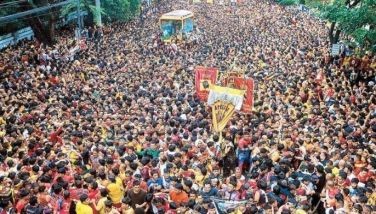Ex-MILF men blamed: ‘Armed lumad group not behind bombings’
August 1, 2002 | 12:00am
COTABATO CITY — North Cotabato Gov. Emmanuel Piñol blamed yesterday a group of kidnappers, who used to belong to the Moro Islamic Liberation Front (MILF), and not the Indigenous People’s Federal Army (IPFA) for Monday’s bomb attacks in his hometown of Mlang.
Piñol, known for his hardline stand against criminal elements, identified a certain Gani Saligan and his followers as those possibly behind the bombings in Mlang which marred the town’s 50th founding anniversary celebration.
Piñol said Saligan "has an ax to grind" against Mlang residents who had refused to allow his group, implicated in more than a dozen kidnappings, to relocate to a farming community there following their surrender to the Philippine National Police last year.
"It was the Muslim residents in Mlang who blocked their plan to relocate there," Piñol said.
According to Army intelligence sources, the letter, purportedly from the IPFA, which was found in one of the blast sites, was not signed by Adrev, the spokesman of the indigenous group.
"It was not identical with those recovered from different areas where the IPFA planted hoax explosives," said a senior Army intelligence officer, who asked not to be identified.
Chief Inspector Jaime Napat, Mlang police chief, said the bombs were planted just meters away from the municipal gymnasium and exploded one after the other while a children’s beauty pageant was being held inside the building.
One of the improvised explosives, Napat said, was placed underneath a pick-up truck of board member George Tejada, parked not far away from the entrance gate of the gymnasium.
Mlang officials said Tejada and Piñol both have pick-up trucks of the same make and color.
Police and Army bomb experts found parts of batteries and electrical circuits at the blast sites, indicating that the explosives were rigged with time-delayed blasting mechanisms.
Piñol, known for his hardline stand against criminal elements, identified a certain Gani Saligan and his followers as those possibly behind the bombings in Mlang which marred the town’s 50th founding anniversary celebration.
Piñol said Saligan "has an ax to grind" against Mlang residents who had refused to allow his group, implicated in more than a dozen kidnappings, to relocate to a farming community there following their surrender to the Philippine National Police last year.
"It was the Muslim residents in Mlang who blocked their plan to relocate there," Piñol said.
According to Army intelligence sources, the letter, purportedly from the IPFA, which was found in one of the blast sites, was not signed by Adrev, the spokesman of the indigenous group.
"It was not identical with those recovered from different areas where the IPFA planted hoax explosives," said a senior Army intelligence officer, who asked not to be identified.
Chief Inspector Jaime Napat, Mlang police chief, said the bombs were planted just meters away from the municipal gymnasium and exploded one after the other while a children’s beauty pageant was being held inside the building.
One of the improvised explosives, Napat said, was placed underneath a pick-up truck of board member George Tejada, parked not far away from the entrance gate of the gymnasium.
Mlang officials said Tejada and Piñol both have pick-up trucks of the same make and color.
Police and Army bomb experts found parts of batteries and electrical circuits at the blast sites, indicating that the explosives were rigged with time-delayed blasting mechanisms.
BrandSpace Articles
<
>
- Latest
- Trending
Trending
Latest
Trending
Latest
Recommended

































